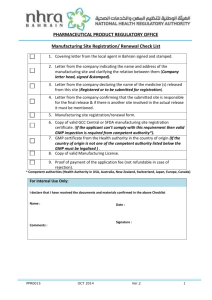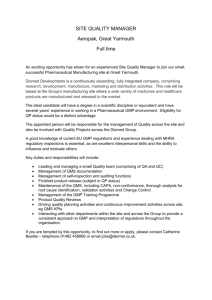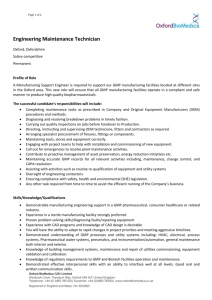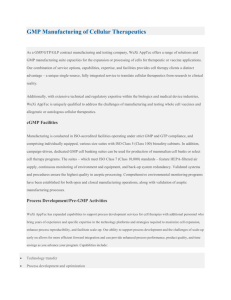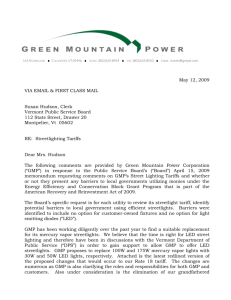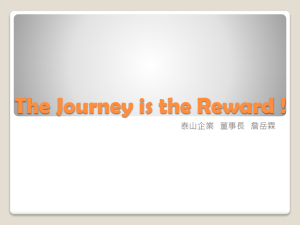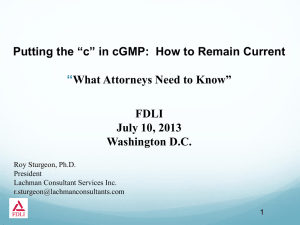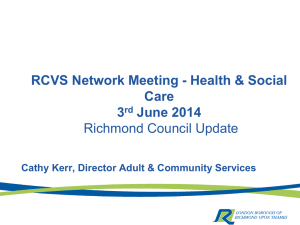cGMP Update
advertisement
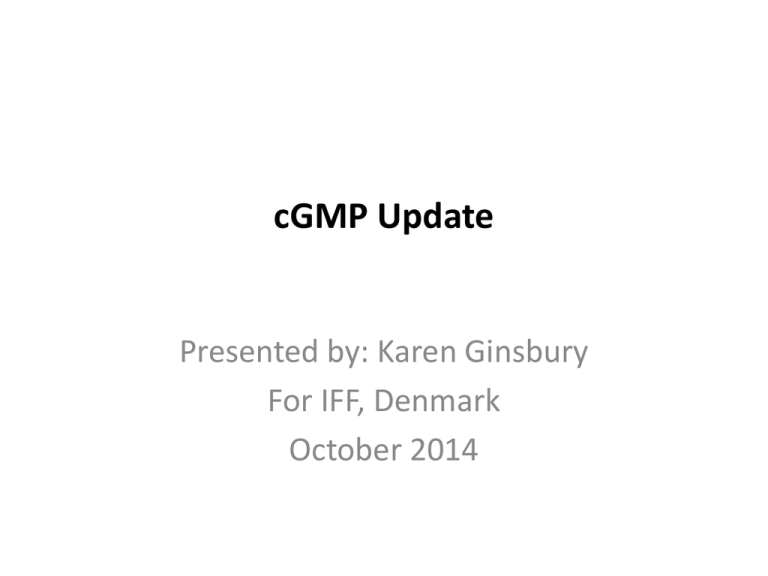
cGMP Update Presented by: Karen Ginsbury For IFF, Denmark October 2014 Do you consider yourself expert in GMP? • Are you a QP? • Is GMP really compatible with an effective, company-wide Quality System? • Discuss… What is Quality What is a Quality System • And who owns it? What is the Role of QA / Quality Unit? • To set up, monitor, report and continually improve the quality system • To ensure compliance with the quality system and that the quality system complies with regulatory requirements • Ensure that there are no contradictions or resolve conflicts Quality is… • Meeting all the requirements all the time • Therefore – not meeting the requirements at any time is not quality • Don’t use “high” or “low” quality – it cheapens the term Waivers • the act of intentionally [and voluntarily] relinquishing or abandoning a known right, claim, or privilege • So a “planned” deviation or “temporary” change or “special” release is a waiver of “quality” which is meeting requirements (all of them all the time) Have you Heard About…ISO2001:2015? Changes: Use of RISK Management and PREVENTION – decrease documentation New Structure Context • Internal and External issues that affect intended outcomes of the quality system • Added emphasis on control of outsourcing • Ensure that externally provided goods and services satisfy the requirements – includes outsourcing Context What are the 9 chapters of EU GMP? Write them down What about Annexes? GMP/GDP Inspectors Working Group What changes in last 12 months Part 1 • Cap 2: Personnel • Cap 3: Premises and Equipt • Cap 5: Production • Cap 6: Quality Control • Cap 8: Complaints, Recalls Effective: • 16 Feb 2014 • 01 Mar 2015 • 01 Mar 2015 • 01 Oct 2014 • 01 Mar 2015 Part 2 APIs Annex 15 Annex 16 • 01 Sep 2014 • Draft out • Draft out 2 - Personnel • Effective Feb 2014 • Changes: – Integrate principles of quality system i.e. ICH Q10 3 – Premises and Equipment 3.6 as part of improved guidance on prevention of cross-contamination involving Cap 5 5 - Production 6 – Quality Control 8 – Complaints, Quality Defects and Product Recalls Annex 15 draft - Validation Annex 16 draft– QP Release Part 2 – Active Substance / API Other • US GMPs: 21CFR parts 210, 211, part 11 and part 820 • FDA guidances: – Quality system guidance vs ICH Q8, 9, 10 – Process validation guidance – Contract Manufacture Other • MHRA Compliance Report program and FDA on quality metrics • WHO Guidances • PIC/s Guidances • USP, European Pharmacopoeia • Pulling together the threads and staying updated Hot Topics – Data Integrity Measurement is the basis of the Quality Process • • • • What do we measure What could we measure What should we measure What can we measure How many metrics • BE CAREFUL – if everything is important then nothing is important About Measurement • “Measurement is the first step that leads to control and eventually to improvement • If you can’t measure something, you can’t understand it • If you can’t understand it, you can’t control it • If you can’t control it, you can’t improve it.” H. James Harrington Measureable…But Meaningful • If a measurement matters at all, it is because it must have some conceivable effect on decisions and behavior • If we can't identify a decision that could be affected by a proposed measurement and how it could change those decisions, then the measurement simply has no value Douglas W. Hubbard, How to Measure Anything: Finding the Value of Intangibles in Business Data Collection Plans • Who decides what data to collect? • How do they make that decision? • How do they COMMUNICATE the decision? (what are the tools) • How do they educate for compliance with the data collection plan? Dashboards • Dashboards are reporting tools that consolidate and arrange numbers, metrics and sometimes scorecards on a single screen • Usually tailored for a specific role • Display metrics targeted for a single point of view or department Dashboards Product vs Process Control Product • Is controlled at the end of the process and you can do nothing about it – you have already made the quality – so you test and if it is ok – release and if it is not ok – you SHOULD reject but you probably get into an OOS fight Process • Is controlled through understanding where the variability is and controlling critical process parameters such that all three cakes come out the same even when baked by three different students in three different ovens The toolbox – Fabulous 14 Tools • • • • • • • • • • • • • • Process flow diagram Cause and effect (fishbone) Pareto chart Check sheets Location diagrams Tally count Time plot Scatter diagram Histogram Stem and Leaf Box and Whisper plot Regression analysis Control Chart Conformance chart The Power of Walking the Floor • Thoughts? The Power of Walking the Floor • “You see but you do not observe” • Just stand and watch a production operation and ask questions about what you see • Talk to operators and LISTEN to their comments In Conclusion • GMP isn’t enough even if “c” • Keep it Simple: – Define requirements – Use Risk Management to identify risks and prevent them from happening – Monitor and improve in a PDCA cycle In Conclusion • Few KEY metrics • Define data collection, analysis and presentation in a Data Collection Plan with standardized templates • Management review and leadership of the program • Follow up and feedback • Walk the floor and LISTEN THANK YOU FOR LISTENING!
